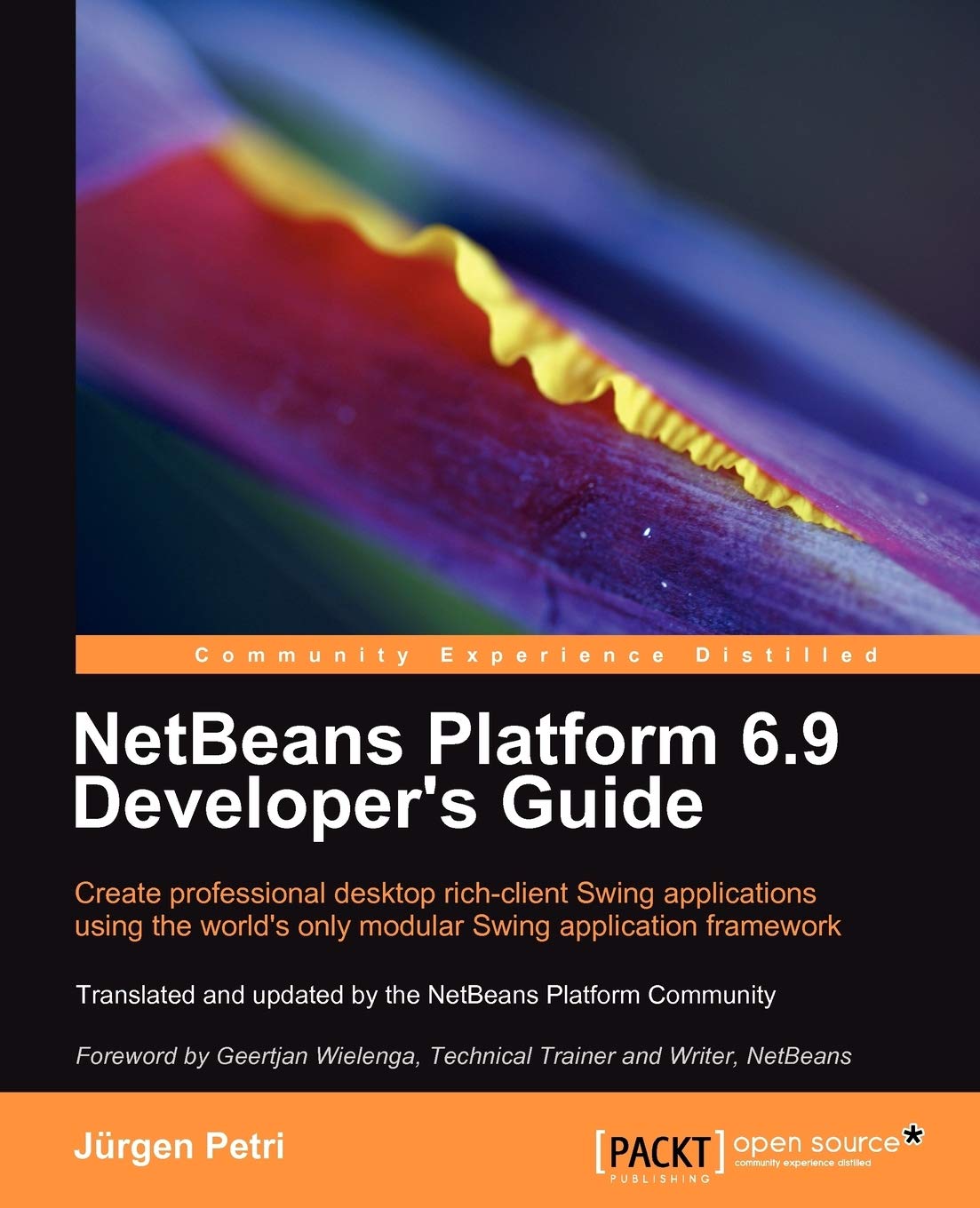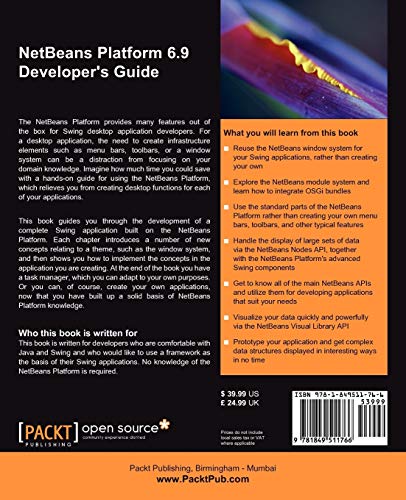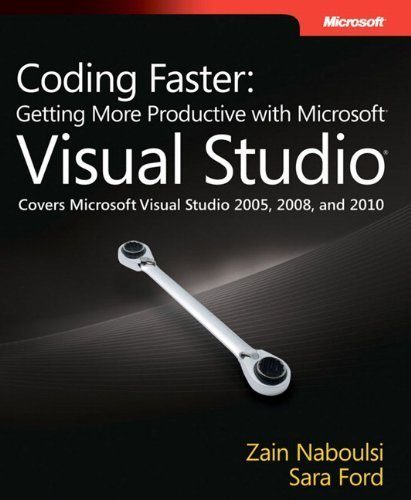
£39.99
Netbeans Platform 6.9 Developer’s Guide by Jürgen Petri Price comparison
Netbeans Platform 6.9 Developer’s Guide by Jürgen Petri Price History
Netbeans Platform 6.9 Developer’s Guide by Jürgen Petri Description
Enhance Your Development Skills with Netbeans Platform 6.9 Developer’s Guide
Unlock the full potential of the Netbeans Platform with the Netbeans Platform 6.9 Developer’s Guide by Jürgen Petri. This comprehensive guide is designed for developers eager to master the intricacies of the Netbeans IDE. Published by Packt Pub Ltd on August 30, 2010, this paperback edition consists of 273 pages packed with essential information and practical examples. If you’re looking to improve your software development skills or simply seeking valuable insights, this guide is indispensable.
Main Features of Netbeans Platform 6.9 Developer’s Guide
- In-Depth Coverage: This book covers all aspects of the Netbeans Platform, providing a strong foundation for both beginners and advanced users. Get detailed insights into essential topics such as module development, user interfaces, and project architecture.
- Practical Exercises: Engage with hands-on projects that illustrate key concepts. Each chapter includes examples and projects that you can work on, allowing you to apply what you learn effectively.
- Updated Techniques: Despite its publication date, the methodologies presented remain relevant. The guide incorporates modern best practices that are essential for success in today’s software development landscape.
- ISBN Details: Easily reference the book with its ISBN-10: 1849511764 and ISBN-13: 978-1849511766, facilitating quick searches for those ready to make a purchase.
- Compact Size: Weighing just 1.12 pounds and measuring 7.5 x 0.75 x 9.25 inches, it’s easy to carry around. Whether you’re at home, in the office, or on the go, this guide can always be at your finger-tips.
Pricing Comparison Across Suppliers
The price of the Netbeans Platform 6.9 Developer’s Guide varies across multiple suppliers. Currently, you can find it at a competitive price on several platforms, making it easier than ever to get this valuable resource. Our price comparison tool ensures you are getting the best deal available to suit your budget. Compare prices now to maximize your savings!
6-Month Price History Trends
Our 6-month price history chart shows a notable trend: the price of this guide has remained stable with minimal fluctuations, making it a reliable investment. We recommend keeping an eye on it for any limited-time promotions. This consistent pricing indicates solid demand for the book, suggesting it’s a trusted choice among developers.
Customer Reviews Summary
Customer feedback on the Netbeans Platform 6.9 Developer’s Guide is largely positive, highlighting its effectiveness as a learning tool. Users appreciate the clear language and logical structure of the content, which makes complex topics accessible. However, some reviewers mention that certain sections could benefit from more practical examples.
On platforms like Amazon, many readers note how the guide improves their understanding of the Netbeans IDE, leading to enhanced development productivity. Positive points include:
- Clear explanations that break down complex concepts.
- Easy-to-follow tutorials that facilitate skill-building.
- Great resource for both novices and experienced developers.
On the flip side, a common drawback mentioned by users is that the book might not cover every advanced feature of the platform, appealing primarily to those focused on basic to intermediate use.
Explore Unboxing and Review Videos
Enhance your understanding of the Netbeans Platform 6.9 Developer’s Guide by watching related unboxing and review videos available on YouTube. These videos provide visual insight into the book’s content and layout, helping you gauge if it meets your needs before making a purchase. Many viewers appreciate seeing key chapters discussed and practical applications demonstrated, which can encourage more informed buying decisions. Search for “Netbeans Platform 6.9 Developer’s Guide Review” for a variety of helpful video content!
Investing in the Netbeans Platform 6.9 Developer’s Guide not only equips you with key knowledge but also positions you at the forefront of software development practices. As you grow your skills, this guide becomes an essential companion that you can always refer back to, ensuring you stay updated in your learning journey.
Don’t miss your chance to enhance your development skills! Compare prices now!
Netbeans Platform 6.9 Developer’s Guide by Jürgen Petri Specification
Specification: Netbeans Platform 6.9 Developer’s Guide by Jürgen Petri
|
Netbeans Platform 6.9 Developer’s Guide by Jürgen Petri Reviews (5)
5 reviews for Netbeans Platform 6.9 Developer’s Guide by Jürgen Petri
Only logged in customers who have purchased this product may leave a review.









boms –
This is a pretty good book to introduce you to the NetBeans Platform. It’s much better than the on-line tutorials which are pretty simplistic. It is not a full reference manual — it does not go into all the possible details. However, it takes you through a very useful application in a step-by-step fashion. You should have a thorough understanding of Java and Swing before starting this book. The author says you don’t need experience with NetBeans IDE, but I disagree. You’ll be lost pretty quick if you don’t know your way around the NetBeans IDE.
My biggest problem is that the code listings in the book are full of errors. You can’t type in the code by hand and expect things to work (I know, I tried). Some of the errors can be figured out by experienced users. Others will cause you to give up in despair in a few hours. The good news is that you can download some of the code from the publisher’s web site. Th bad news is it only covers chapters 2 through the middle of chapter 6. The rest of chapter 6 and all of chapters 7-13 you’re on your own. I couldn’t get examples from the later chapters to run by typing stuff in directly. For chapter 4, even the downloaded code did not run on my Mac computer (some of his directories had uppercase letters that needed to be lower case letters to run on a Mac).
Having said that, there are a lot of good things too. The best chapter was on Lookup (chapter 4). From the on-line tutorials, I’ve been mystified as to what it does and why I need it. There were plenty of examples in chapter 4 that helped make that clear. The biggest disappointment was chapters 7 & 8 on file systems and data. It almost seemed like the author was getting tired of writing at this point.
Don’t expect detailed explanations on how everything works. Some of the code is still cryptic (i.e. type this in and watch how it works). You’ll need to dig into the APIs yourself to get a better understanding of the details of why the cryptic code does what is does. However, at least you’ll be pointed in the right direction.
I was tempted to give only 3 stars, but there’s really no other book that fills this gap and I’m still glad I bought it. Now, I’m looking for a book that delves into all the details.
Amazon Customer –
The tutorial layout for this book is pretty good. The author guides you to write an application called the TaskManager. Along the way, it explains how NetBeans Platform work, and how you can take advantage of the modules framework.
Similar to several other reviewers here, the code in the example has lots of errors. Occasionally subtle things are omitted and are left as user exercise. There is a website “[…]” that documents all the errors. I recommend you to follow the website closely as you are working on the TaskManager application.
One thing worth mentioning is that NetBeans 7.x (7.2.1 as of today) has changed the way how layer.xml works. NetBeans 7.x improved upon the clunky layer.xml file and heavily utilizes Java annotation. Therefore, you will likely encounter some difficulties with the chapter on layer.xml (Ch.3 I believe). If you have no idea what I am talking about, it might be better to wait for a newer revision of this book.
… Alan
GeofM –
As with all the books and help documentation from the NetBeans community, if you already understand almost all of the structure and modes of use of the NetBeans platform, it provides a good reference manual guide to remind you of something you aren’t quite sure you can remember correctly.
If you want to learn how to use the platform as a new user, unfamiliar with the structure and meaning of its various components, get ready for a hard time. In this case, as in other cases I have read, it gives a nice simple introduction to a single, highly limited use of the platform, but when you try to transfer what it says over to some more practical application of your own you will find you can’t, without a great deal of searching on the web among numerous guides, each of which interweaves a need to go to another place to gain an understanding.
If you work at it hard enough you will get there in the end, but if, like me you aren’t very quick on the uptake there is a serious chance that you will end up in a state home for the bewildered.
All that said, the platform is very powerful and flexible and you can download it for free, so it is worth the effort. I am fairly sure I would have made an even worse try at producing documentation for new users, so although I am critical of it, it is still one of the best available.
Mr JC Luque-Beltran –
Good book lost to learn an to put in practice. Thanks
W. Prakash –
It is more than 2 years since I developed plugins for the Netbeans IDE. I guess, the last version of the Netbeans IDE I worked on was 6.1. When I got this complementary book, I was curious to know what has changed since 6.1. I decided to write a review after I finished reading this book.
When I started reading this book, I immediately wished I had this book several years ago, when I had to pour through actual code to understand several of the concepts. This book is written for Platform Developers, but in my opinion this book is also well suited for plugin developers who would end up using several of the concepts covered in this book. This book is not a reference book which covers all the zillions of Platform API in Netbeans, but certainly a very good book for beginners and advanced users who wished to grasp the fundamental principle of developing a standalone application using Netbeans Platform.
When you have decided to create you application using Netbeans RCP (Rich Client Platform), the initial task is to create a project and corresponding artifacts to work with. How to do that task is explained in chapter 1. Netbeans has a wonderful GUI builder called Matisse. You can use this GUI builder to develop most the UI’s of your application, which is explained in chapter 2.
The primary building block of the Netbeans RCP application is windowing system. As an experienced Netbeans plugins developer, I believe, it is very important to understand the concepts of windowing system. This is well explained in chapter 3.
Netbeans Platform provides rich set of services which an application developer can leverage. A mechanism called “Lookup” provides way to find these services as well register your own services. This is covered in chapter 4, which also explains how to handle communication between services and listen to dynamic changes etc.
User interaction of a RCP application is usually through Menus, Popup or Context menu, Dialogs, Wizards or intractable UI such as Tree like Explorer. Concept called “Action” is used for creating Menus which is explained in chapter 5. Nodes and Explorer views are two terms used for creating Tree like Explorer. This is explained in Chapter 6. Dialogs and Wizards are covered in Chapter 8.
Several time the application need to interact with the native File System as well able to show data from files to the user. Netbeans provides API to achieve this which is covered in Chapter 7 and 8.
Highly interactive applications always have some kind of settings which can be tweaked by user. The settings need to be persisted for next session. Netbeans Options API provided rich interface for settings which is explained in Chapter 11.
Once the application is ready, the next task is to write help on how to use various pieces of the application. For this task Netbeans provides Help API which is covered in chapter 11. Before starting to distribute, the application need to be branded to reflect your company branding, which is explained in chapter 12.
The final step of Application life cycle is distribution. Once the application is successfully distributed, there should be provision for periodic update. Netbeans auto update mechanism is a powerful way of keeping your customers happy with periodic update which is explained in Chapter 3.
I recommend this book as a quick guide for building initial scaffold of your application and how to glue together various RCP aspects to create the initial application. However, you might also need more advanced book which has in depth coverage of Netbeans RCP API for reference.